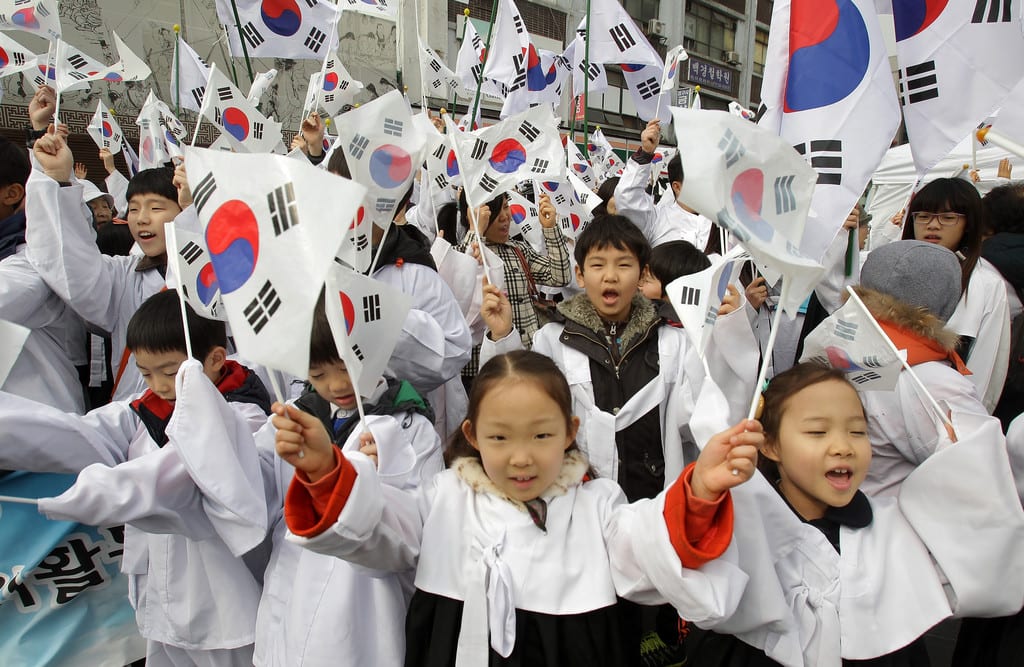Today is Korea’s National Independence Movement Day called Samiljeol or 삼일절 (3-1). It is also known as March 1st Movement or Mansae Demonstrastions (만세운동, Mansae Undong). It is celebrated in both North and South Korea. The movement was an uprising to resist Japanese occupation and oppression in Korea.
In 1905, Japan invaded Korea and oppressed the Korean citizens for almost ten years. Because the Japanese Government was unjust concerning labor laws, employment, education, and more, the Korean population felt a strong need for independence.
In January 1918, during the peace negotiations to end WWI, U.S. President Woodrow Wilson introduced the “Fourteen Points,” a statement of principles for peace. As a result of President Wilson’s speech, some students who were studying in Tokyo were inspired to write a statement demanding independence.
A year later, amongst all the disarray, the former Emperor Gojong died on January 21st, 1919. His death, which many suspected was due to poison, caused a spark to the movement. On March 1st, 33 activists and religious leaders (consisting of 9 Methodists, 7 Protestants, 15 Ch’ondogyo, and 2 Buddhists) gathered at a restaurant in Seoul to formulate the Korean Declaration of Independence. The document was written by historian Choe Nam-Seon and was read, signed, and then sent to the Japanese Governor. The leaders then contacted local police to inform of their activities and were arrested.

33 activists and religious leaders at Taehwagwan Restaurant


Korean Declaration of Independence
“We herewith proclaim the independence of Korea and the liberty of the Korean people. We tell it to the world in witness of the equality of all nations and we pass it on to our posterity as their inherent right.We make this proclamation, having 5,000 years of history, and 20,000,000 united loyal people. We take this step to insure to our children for all time to come, personal liberty in accord with the awakening consciousness of this new era. This is the clear leading of God, the moving principle of the present age, the whole human race’s just claim. It is something that cannot be stamped out, stifled, gagged, or suppressed by any means.”
(The full Korean Declaration of Independence can be read here.)
At 2 p.m. in Pagoda Park, also known as Tapgol Park, a student by the name of Chung Jae-Yong read the declaration, along with other delegates in various parts of the country at the same time, creating a large gathering and peaceful processions in the streets. Two million people marched and protested in over 1,500 demonstrations. Japanese police tried to control the crowds to no avail. The military then had to be summoned, beginning a period of 12 full months where they attempted to gain control of the people. As a result, numerous casualties from brutality occurred with the most well-known case in the village of Jeam-ri, where policed gathered all the residents into a church, burning it down and shooting into the flames to ensure no one could flee from the burning building.


March 1st peaceful demonstration
Sometimes referred to as ” The Bloody History of the Korean Independence Movement,” it is reported that 7,509 people were killed, 15,849 were wounded, and 46,303 were arrested (who were taken to the infamous Seodaemun Prison). The movement activists fled to parts of China where they continued their activism. The Japanese Government tried to suppress the movement, calling it the “Choseon Manse Violent Public Disorder Incident” (조선 공공 만세 폭력 사건).
The movement prompted the formation of the Provisional Government of the Republic of Korea and the Korean Liberation Army in China, where ultimately independence was achieved after WWII in 1945. To remember the souls who protested in bravery so long before, the day was set as a national holiday on May 24th, 1949.
Every year, Koreans celebrate the March 1st Independence Movement by reenacting the processions and reading the Declaration of Independence in Pagoda Park. The Korean flag, Taegeugki (태극기), is raised throughout the country while parades, concerts, and events occur throughout the holiday.


Students march in Samil Parade






Reenactment of March 1st Independence Movement
On this day, many Koreans and tourists visit Seodaemun Prison History Hall (서대문형무소). It was opened in 1908 for Korean activists who opposed the Japanese occupation. The museum presents the struggles and torture of the prisoners. To learn more about this museum click here.


Seodaemun Prison History Hall (서대문형무소)


Seodaemun Prison Cells
Another tourist attraction is the Independence Hall of Korea (독립기념관). It has seven exhibition halls that consist of artifacts, photographs, dioramas, models, etc. To learn more about this museum click here.


Front of Independence Hall of Korea


The Monument of the Nation
The Korean Independence Day Movement is both a historically joyous and solemn occasion. The day is filled with tears for the loss of lives during the protests and gratitude for their contribution to Korea’s freedom. Their ancestors have bravely protested to help shape Korea to what it is today.
Panamami started listening to Kpop and watching Kdramas in early Feb 2015. She finally succeeded in getting her best friend into it a year later. Hey favorite group is BTS and her bias is Rap Monster. She also listens to Jay Park and Illionaire and loves discovering new songs with her friend. Panamami loves animals and has a dog and two cats. When not watching Kdramas or working, she can be seen working at a horse farm.
Media: As Credited


